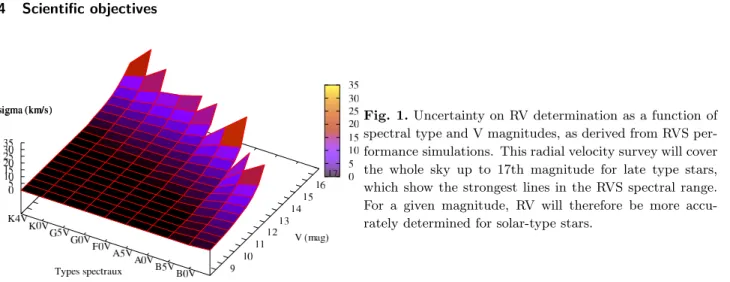SF2A 2009
M. Heydari-Malayeri, C. Reyl´e and R. Samadi (eds)
GAIA RVS DATA REDUCTION : THE 6
T HDIMENSION
Meynadier, F.
1, Crifo, F.
1, Katz, D.
1, Th´evenin, F.
2, Berthier, J.
5, Bigot, L.
2, Delle Luche, C.
1,
Doressoundiram, A.
3, Gomez, A.
1, Guerrier, A.
4, Hestroffer, D.
5, Hubert, A.-M..
1, Jasniewicz, G.
6,
Jean-Antoine, A.
4, Ludwig, H.
1, Martayan, C.
1, Nguyen, A.-T.
4, Ocvirk, P.
7, Pichon, B.
2, Royer,
F.
1, Sartoretti, P.
1, Siebert, A.
8, Soubiran, C.
9, Turon, C.
1, Veltz, L.
7and Viala, Y.
1 Abstract. This poster describes the current organisation of RVS data processing among the Gaia-DPAC (Data Processing & Analysis Consortium), with a particular focus on the French community’s contribution.1 Introduction
The Radial Velocity Spectrometer (RVS) is a slitless spectrometer which will operate in the Gaia satellite. As its name suggests it will, amongst other tasks, determine the radial velocity of a large number of sources (100 to 200 million) : this will give us access to the only component of the star’s velocity which can not be determined by astrometry. It has to be noted that measuring radial velocity simultaneously with astrometric and photometric parameters measurements is a significant improvement over Gaia’s precursor, the Hipparcos mission.
2 RVS Data reduction within the global GAIA data reduction scheme
The Gaia Data Processing & Analysis Consortium (DPAC) is organised into several coordination units which cover the whole data processing chain. One of these coordination units, CU6, is devoted to the RVS data processing, taking almost raw instrumental data as input. Its output is then directed to the Main Database (which will feed the catalogue) and to other scientific chains for further analysis.
In practice, the CU6 algorithms will be run at the CNES Data Processing Center which will also host CU4 (Object processing) and CU8 (Astrophysical Parameters) software. The CNES is responsible for integrating the software modules written by scientists in Java, and running them on dedicated hardware.
3 Processing chain
The processing chain is divided into 5 packages : Extraction, calibration, radial velocity zero-point, single transit analysis and multiple transits analysis.
The first step is to retrieve pixel blocks, disentangle overlapping objects, remove contaminants and perform appropriate geometric transformations in order to output a cleaned 1D spectrum.
The calibration step is indeed a self-calibration, as there is no internal calibration source. This self-calibration relies on redundant observations throughout the mission.
1
GEPI–Observatoire de Paris UMR 8111, 5, place Jules Janssen 92195 Meudon cedex
2
Cassiop´ee–Observatoire de la Cˆote d’Azur UMR6202, BP 4229 06304 NICE Cedex 4
3
LESIA–Observatoire de Paris UMR 8109, 5, place Jules Janssen 92195 Meudon cedex
4
CNES, 18 avenue Edouard Belin, 31 401 TOULOUSE CEDEX 9
5
IMCCE–Observatoire de Paris UMR 8028, 77 avenue Denfert-Rochereau, 75014 Paris
6
GRAAL–UMR5024, Universit´e de Montpellier II, Place Eug`ene Bataillon - CC 72, 34095 Montpellier C´edex 05 FRANCE
7
Astrophysikalisches Institut Potsdam, An der Sternwarte 16, D-14482 Potsdam
8
Observatoire Astronomique de Strasbourg UMR 7550, 11 rue de l’Universit´e 67000 Strasbourg
9
Laboratoire d’Astrophysique de Bordeaux UMR 5804, 2, rue de l’Observatoire - BP 89 -33270 Floirac c
64 SF2A 2009
Zero-point determination for radial velocities supposes a wide search for RV standard stars with homogeneous coverage of the sky. This is currently performed by several ground-based observation programmes, which data will be compared to RVS measurements in order to settle the RV zero-point (see poster by Crifo et al., this meeting).
“Single Transit Analysis” (STA) consists in fitting template spectra to the measured spectra, thus deter-mining the source’s radial velocity for each “transit” (meaning “each time the source passes across the focal plane”).
“Multiple Transit Analysis” (MTA) gathers data from STA every 6 months and performs additional analysis (such as variability detection and basic modelling).
4 Scientific objectives
Fig. 1.Uncertainty on RV determination as a function of spectral type and V magnitudes, as derived from RVS per-formance simulations. This radial velocity survey will cover the whole sky up to 17th magnitude for late type stars, which show the strongest lines in the RVS spectral range. For a given magnitude, RV will therefore be more accu-rately determined for solar-type stars.
This survey will contribute to our knowledge of the Galaxy’s kinematics and dynamics, but the spectra will also bring some information about effective temperature and surface gravity. Some emission lines will also be detected and will help characterizing B[e] stars or stars with envelopes or accretion discs. Other goals are reachable when analysing RVS data together with photometric data collected by the BP/RP instrument : chemical abundances will be determined for a large number of sources, which will allow to study their distribution and therefore bring insights about the dynamical and chemical of the galaxy, origin of the halo, the search for extremely metal-poor objects, studies of the thick disk. Open questions like the existence of a vertical chemical gradient in the disk may be addressed, and the chemical aspects of stellar associations and streams that Gaia will find will be studied.
5 French involvement
The French astrophysical community is strongly represented in the RVS data processing preparation, in col-laboration with (mainly) UK (Mullard Space Science Laboratory) and Belgium (Observatoire Royal, Institut d’Astrophysique et de G´eophysique).
David Katz (GEPI–Observatoire de Paris) is the coordinator of this unit, assisted by Mark Cropper (MSSL, UK) and Fr´ed´eric Meynadier (GEPI). The first two steps of the processing chain (extraction and calibration) as well as MTA are under MSSL responsibility; zero-point determination is led by G´erard Jasniewicz (GRAAL, Universit´e de Montpellier) and STA is led by Yves Viala (GEPI). Specific CU6 simulations are realised by Paola Sartoretti (GEPI). On CNES side, technical coordinator Anne Jean-Antoine Piccolo and quality insurance manager Anne-Th´er`ese Nguyen are responsible for integrating and running the software for CU6.
Overall, the 26 persons whose names appear on this poster account for approximatively half of the people working for CU6 across Europe.
